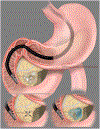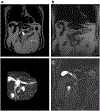EUS-Guided Pancreatic Cyst Ablation: a Clinical and Technical Review
- PMID: 31016391
- PMCID: PMC11613143
- DOI: 10.1007/s11894-019-0686-5
EUS-Guided Pancreatic Cyst Ablation: a Clinical and Technical Review
Abstract
Purpose of review: Pancreatic cystic lesions represent a growing public health dilemma, particularly as our population ages and cross-sectional imaging becomes more sensitive. Mucinous cysts carry a clinically significant risk of developing pancreatic cancer, which carries an extremely poor prognosis. Determining which cysts will develop cancer may be challenging, and surgical resection of the pancreas carries significant morbidity. The goal of this paper is to review the rationale for cyst ablation and discuss prior and current research on cyst ablation techniques and efficacy. Indications, contraindications, and factors related to optimal patient selection are outlined.
Recent findings: Endoscopic ultrasound-guided chemoablation of pancreatic cysts has been performed in neoplastic cysts, with varying levels of efficacy. Safety concerns arose due to the risk of pancreatitis in alcohol-based treatments; however, the most recent data using a non-alcohol chemoablation cocktail suggests that ablation is effective without the need for alcohol, resulting in a significantly more favorable adverse event profile. Endoscopic ultrasound-guided chemoablation of neoplastic pancreatic cysts is a promising, minimally invasive approach for treatment of cysts, with recent significant advances in safety and efficacy, suggesting that it should play a role in the treatment algorithm.
Keywords: Pancreatic cancer prevention; Pancreatic cyst ablation; Pancreatic cyst treatment.
Conflict of interest statement
Jennifer L. Maranki, and JohnM. DeWitt declare no conflict of interest.
Figures


Similar articles
-
Endoscopic Ultrasound-Guided Ablation of Pancreatic Mucinous Cysts.Gastrointest Endosc Clin N Am. 2024 Jul;34(3):537-552. doi: 10.1016/j.giec.2024.02.005. Epub 2024 Mar 13. Gastrointest Endosc Clin N Am. 2024. PMID: 38796298 Free PMC article. Review.
-
The Safety and Efficacy of an Alcohol-Free Pancreatic Cyst Ablation Protocol.Gastroenterology. 2017 Nov;153(5):1295-1303. doi: 10.1053/j.gastro.2017.08.009. Epub 2017 Aug 9. Gastroenterology. 2017. PMID: 28802565 Clinical Trial.
-
Endoscopic ultrasound-guided ablation is a promising treatment for pancreatic cystic neoplasms - a systematic review.Dan Med J. 2020 Aug 1;67(8):A01200019. Dan Med J. 2020. PMID: 32741440
-
Alterations in cyst fluid genetics following endoscopic ultrasound-guided pancreatic cyst ablation with ethanol and paclitaxel.Endoscopy. 2014 Jun;46(6):457-64. doi: 10.1055/s-0034-1365496. Epub 2014 Apr 25. Endoscopy. 2014. PMID: 24770971 Clinical Trial.
-
Endoscopic ultrasound-guided ethanol ablation therapy for tumors.World J Gastroenterol. 2013 Jun 14;19(22):3397-403. doi: 10.3748/wjg.v19.i22.3397. World J Gastroenterol. 2013. PMID: 23801831 Free PMC article. Review.
Cited by
-
Current Endoscopic and Surgical Management of Pancreatic Cystic Lesions: A Comprehensive Review.Turk J Gastroenterol. 2024 Nov 4;36(1):6-14. doi: 10.5152/tjg.2024.24124. Online ahead of print. Turk J Gastroenterol. 2024. PMID: 39634190 Free PMC article. Review.
-
An update on EUS-guided ablative techniques for pancreatic cystic lesions.Endosc Ultrasound. 2022 Nov-Dec;11(6):432-441. doi: 10.4103/EUS-D-21-00178. Endosc Ultrasound. 2022. PMID: 35313421 Free PMC article. Review.
-
High-risk main-duct intraductal papillary mucinous neoplasm successfully treated with EUS-guided chemoablation.VideoGIE. 2020 Aug 27;5(12):679-680. doi: 10.1016/j.vgie.2020.07.022. eCollection 2020 Dec. VideoGIE. 2020. PMID: 33319141 Free PMC article. No abstract available.
-
State-of-the-Art Update of Pancreatic Cysts.Dig Dis Sci. 2022 May;67(5):1573-1587. doi: 10.1007/s10620-021-07084-1. Epub 2021 Aug 12. Dig Dis Sci. 2022. PMID: 34383196 Free PMC article. Review.
-
Endoscopic Ultrasound-Guided Ablation of Premalignant Pancreatic Cysts and Pancreatic Cancer.Diagnostics (Basel). 2024 Mar 6;14(5):564. doi: 10.3390/diagnostics14050564. Diagnostics (Basel). 2024. PMID: 38473035 Free PMC article. Review.
References
-
- Rahib L, Smith BD, Aizenberg R, Rosenzweig AB, Fleshman JM, Matrisian LM. Projecting cancer incidence and deaths to 2030: the unexpected burden of thyroid, liver, and pancreas cancers in the United States. Cancer Res. 2014;74:2913–21. - PubMed
-
- Ryan DP, Hong TS, Bardeesy N. Pancreatic adenocarcinoma. N Engl J Med. 2014;371:1039–49. - PubMed
-
- American Cancer Society. Cancer facts & figures 2018. Atlanta: American Cancer Society; 2018.
-
- Fernandez-Del Castillo C, Tanaka M. Management of pancreatic cysts: the evidence is not here yet. Gastroenterology. 2015;148: 685–7. - PubMed
-
- de Jong K, Nio CY, Hermans JJ, Dijkgraaf MG, Gouma DJ, van Eijck CHJ, et al. High prevalence of pancreatic cysts detected by screening magnetic resonance imaging examinations. Clin Gastroenterol Hepatol. 2010;8:806–11. - PubMed
Publication types
MeSH terms
Substances
Grants and funding
LinkOut - more resources
Full Text Sources
Medical
Research Materials

